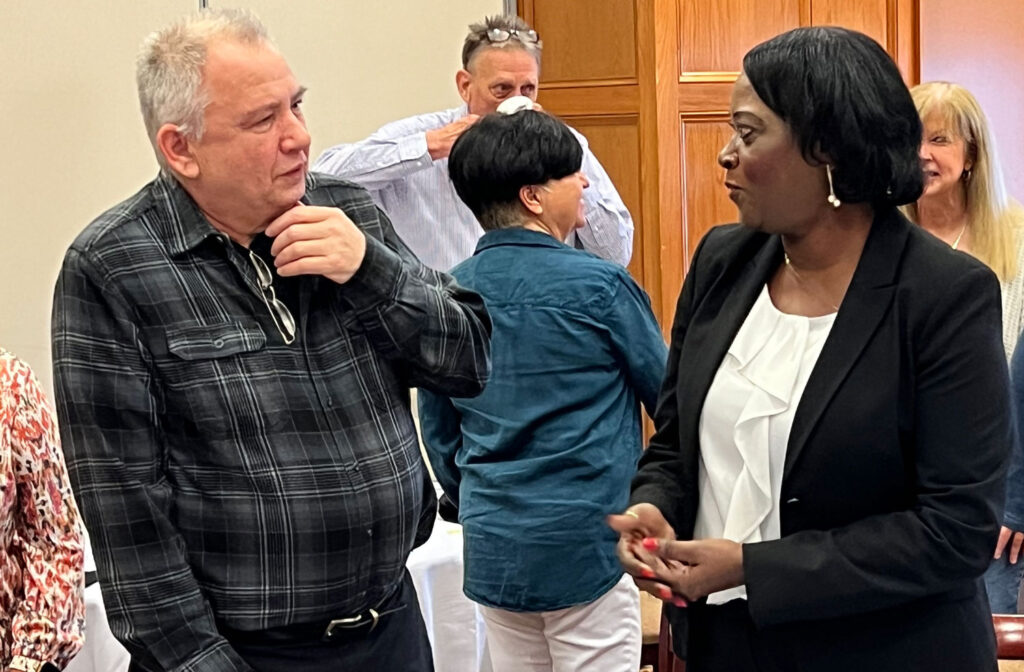Lowndes County Emergency Management Agency Director Cindy Lawrence learned how to work a disaster the hard way.
She took the EMA director’s job in 2000, and, in February 2001, a massive wall of straight-line winds hit Lowndes County.
That, Lawrence told the Columbus Exchange Club Thursday afternoon, was her introduction to working a large-scale disaster.
“It hit around lunchtime, and I went out to go to lunch and it was very windy,” Lawrence said. “I decided to go back inside and wait until the winds died down.”
Rather than dying down, winds roared through the area, taking down phone and power lines across Lowndes County.
“I was sitting at my desk when the National Weather Service called and said we were going to be hit by a storm,” Lawrence said. “I told them no, we just got hit by a storm. It was already past. I was by myself, and I was almost clueless because I had just started.”
Lawrence said that storm was still the worst destruction she has seen in Lowndes County, and it taught her a valuable lesson.
“When you have disasters, you have to have plans and you have to practice those plans,” she said. “It’s not just writing things down.”
Hurricane Katrina in August 2005 underlined that lesson, she said.
“You have your paper, you have your plans (and) you know what you’re going to do, but when it’s that large-scale, you have to throw the plan out the window,” Lawrence said. “From that we decided to create a team, and all the (emergency) agencies are going to work under one coordinator.”
The county’s plans follow the National Incident Management Plan, which was put into place by the George W. Bush administration, Lawrence said.
“The training that I get here locally, I can go anywhere in the United States and work because we all train under the same system,” Lawrence said.
Planning isn’t just for the government, though, Lawrence said. She constantly urges businesses to have concrete disaster plans, especially those that deal with people who are already vulnerable, such as nursing homes.
“They work with people with limited mobility as well as those who are completely bedridden,” she said. “I ask them to do exercises, even if it’s just one person. See how long it takes you to get that one person from their room to your safe place.”
The lack of public shelters is a stumbling block, Lawrence said.
“Unfortunately we don’t have community shelters,” she said. “New Hope, Caledonia and the Lowndes County Career Technology Center have storm shelters built into the schools, but if school’s in session, we don’t have access to them because the students are using them.”
She said people should designate a sturdy, interior room in their home as a de facto storm shelter and stay there until the storm passes.
Past attempts to install government-funded individual shelters at people’s homes have met with resistance, Lawrence said. The federal government offered to pay for 15 shelters at homes in Lowndes County.
“That was the most tedious task,” Lawrence said. “People kept asking me, ‘Is the government going to take my property?’ I wasn’t able to find 15 people, but I did get 10 in.”
Heavy rains this week
In spite of widespread flood warnings, actual flooding was limited, Lawrence said. She said only two roads in the county had to be closed due to high water: Hobbs Shelton Road and Old Macon Road.
She advised people who live in low-lying areas to keep a watch on rising water levels when there is a flood threat forecast, even if it’s by doing something low-tech.
“Put a stick out there (in your yard),” Lawrence said. “Go back and check in an hour. If the water’s gotten to the stick, that means it’s rising and it’s time to start thinking about where you’re going to get to higher ground.”
On a more positive note, the rains will hopefully lessen the fire risk, Lawrence said.
“It’s not greatly impacted the drought, but it’s impacted it some,” she said. “We hope that it’s going to stop these grass fires. Right before the ice storm we just had so many grass fires.”
National Weather Service-Jackson Lead Meteorologist David Cox told The Dispatch Wednesday he thought the rain would put a “big dent” in the drought conditions.
“We’ve had really long-term drought issues that have been … probably 10-plus inches behind in spots,” Cox said. “For the Lowndes County area, the rain (amounts) aren’t as high. It’s definitely going to make a big dent, but not as much in the northeast part of the state as in others.”
Brian Jones is the local government reporter for Columbus and Lowndes County.
You can help your community
Quality, in-depth journalism is essential to a healthy community. The Dispatch brings you the most complete reporting and insightful commentary in the Golden Triangle, but we need your help to continue our efforts. In the past week, our reporters have posted 45 articles to cdispatch.com. Please consider subscribing to our website for only $2.30 per week to help support local journalism and our community.







